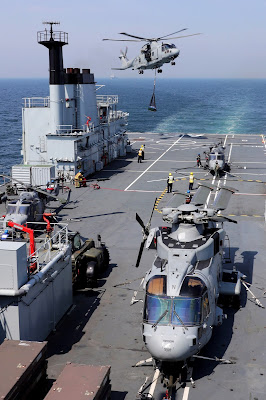Having first flown sixty years ago,long before anyone had thought to incorporate features such as crashworthiness and visual,acoustic,thermal and radio signature reduction in to helicopter designs,the Chinook has long been recognised as obsolescent by the United States' Army.
Over the years,there have been many attempts to develop a replacement for the Chinook,such as the Aerial Cargo Transport,Future Transport Rotorcraft,Air Maneuver Transport,Joint Heavy Lift and later Joint Future Theater Lift projects but,unfortunately,the United States' Army is about as good at developing military helicopters as the England football team is at World Cup penalty shootouts,having not successfully developed a new helicopter since the Apache,which first flew forty-six years ago,since then thousands of millions of United States' dollars have been wasted on a long series of failures such as the Comanche and Arapaho.
Over the same period,the United Kingdom's helicopter industry has successfully developed the Merlin and Wildcat helicopters,the latter being delivered both on time and on budget,a stark contrast to comparable American and European projects.
Nevertheless,the United States' Army's unimpressive record has clearly impressed Minister for the Armed Forces James Heappey,who in July of Twenty Twenty signed a Memorandum of Agreement intended "to share and understand each nation’s conceptual thinking for the development and application of Rotary Wing Capability",which is rather like asking Gerald Ratner to share tips on jewelry retailing,Mister Heappey concluded: "I could not be, nor have been, any clearer that this is absolutely not about the UK purchasing US kit.".
Picture: Original image Sergeant Charles Probst,United States' Army photograph,modifications by unknown artist,Bell Helicopter
The United States' Army's plans to terminate Chinook production and instead invest in Future Vertical Lift,it's most recent ill conceived rotorcraft project,have run in to opposition from American politicians more interested in protecting eighteen thousand jobs in their constituencies than in equipping their army with modern helicopters.
As the Littoral Combat Ship project demonstrated,American politicians are happy to waste tens of thousands of millions of dollars on useless equipment as long as it benefits their electorate and campaign donors,British politicians are also keen to buy useless military equipment to protect jobs,as long as it is not British made equipment,or British jobs.
On the Nineteenth of November,Twenty Twenty the United Kingdom's Prime Minister,Boris Johnson,told Parliament: "Our plans will safeguard hundreds of thousands of jobs in the defence industry,protecting livelihoods across the UK and";"allow our new investment to be focused on the technologies that will revolutionise warfare";"to restore Britain’s position as the foremost naval power in Europe".
Six months later,his Secretary of State for Defence threatened thousands of jobs in the British helicopter industry by ordering more American built Chinook helicopters,the last of which shall be entering service seventy years after the Chinook first flew (and may still be in service after it's centenary) and none of which shall be suited to naval use.
The Chinook entered service with the Royal Air Force as an army support asset back in Nineteen Eighty,despite at one point being intended to provide logistical support for Royal Air Force Harriers,a concept which was as absurd as the Harrier it's self,as they were based behind friendly lines and could easily be supplied by truck.
British forces first used the Chinook in combat during the Falklands War,being incapable of operating from most warships,four of them sailed south from Ascension Island in a disassembled state on the Steam Ship Atlantic Conveyor,three subsequently being lost when that ship was hit by Exocet missiles,leaving the task force crippled by it's dependence on a single Royal Air Force heavy lift helicopter and a large number of Royal Navy and British Army helicopters,such as the Scout,Wasp,Gazelle,Lynx,Wessex and Sea King,none of which could carry as much as a Chinook,but all of which could operate from warships.
Four decades later,the Royal Navy and British Army now have new Wildcat helicopters which are well suited to operating from warships,but which have little useful payload,while the Royal Air Force is purchasing new Chinooks,which have adequate payload but which are inherently unsuited to naval use and incapable of operating from most British warships,thanks to which the British armed forces shall be lumbered with the same problem they had four decades ago for the next forty years.
The Ministry of Defence is clearly not a learning institution.
Is it Mister Wallace?












